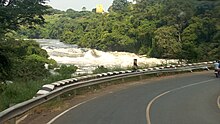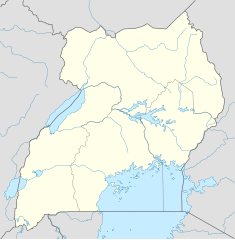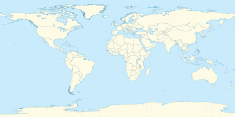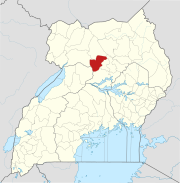Dam in Karuma Falls
| Karuma Hydro Power Station | |
|---|---|
 Karuma Bridge Karuma Bridge | |
   | |
| Official name | Karuma Hydropower Station |
| Country | Uganda |
| Location | Karuma Falls |
| Coordinates | 2°14′55″N 32°16′06″E / 2.24861°N 32.26833°E / 2.24861; 32.26833 |
| Status | Operational |
| Construction began | 16 December 2013 |
| Opening date | 26 September 2024 |
| Construction cost | US$1,688,380,000 |
| Owner(s) | Uganda Government |
| Operator(s) | Uganda Electricity Generation Company Limited (UEGCL) |
| Dam and spillways | |
| Type of dam | Mass concrete |
| Impounds | Victoria Nile |
| Height | 14 |
| Length | 314.43 |
| Elevation at crest | 1032 |
| Spillways | 8 |
| Reservoir | |
| Total capacity | 79,870,000 cubic metres (2.820582431×10 cu ft) |
| Normal elevation | 1,000 m (3,300 ft) |
| Operator(s) | UEGCL |
| Commission date | 26 September 2024 |
| Type | Run of the river |
| Hydraulic head | 71 metres (233 ft) |
| Turbines | 6 x 100 MW (Francis) |
| Installed capacity | 600 MW |
| Annual generation | 4,373 GWh |
The Karuma Hydroelectric Power Station is an operational 600 MW hydroelectric power station in Uganda. It is the largest power-generating installation in the country.
Location
The power station is located on the Victoria Nile, at the former location of the Karuma Falls. This location is approximately 2.5 kilometres (1.6 mi) upstream of where the Masindi-Gulu Highway crosses the Nile. By road, it is approximately 99 kilometres (62 mi) northeast of Masindi and 75 kilometres (47 mi) south of Gulu.
The electrical-mechanical installations of the power station are located approximately 100 metres (328 ft) underground, with 26.5 kilometres (16 mi) of underground access roads, making Karuma the 14th largest underground power station in the world.
History
As far back as 1995, the government of Uganda planned to construct a hydropower station at the site of the Karuma Falls. Initially, Norpak, a Norwegian energy company, was awarded the contract to perform the feasibility study and the environmental impact assessment (EIA) for the dam. The World Bank promised to make a loan available to pay for the construction. The feasibility study report was made available in October 2006. Bids for construction of the project went out in November 2006. Initially, the plan was to build a 200-250 megawatt power station.
In 2009, the plans were redrawn, calling for a much larger project of 750 megawatts. Sometime during 2009, Norpak pulled out of the negotiations with the Ugandan government, citing the Global Recession of 2008 to 2012.
The Ugandan government then contracted with Energy Infratech Private Limited to perform a new feasibility study and a new EIA, given that a larger power station was now being planned. At that time, construction was expected to start in 2012 and last six years.
In July 2011, media reports indicated that the maximum capacity of the project had been scaled back to 600 megawatts from 750 megawatts. Some international development partners wanted to scale back even further, to a maximum capacity of 400 to 450 megawatts.
Technical specifications
Karuma Power Station comprises a roller compacted concrete gravity dam, that measures 20 metres (66 ft) high and 312 metres (1,024 ft) long. There are six water intake towers, each measuring 20 metres (66 ft) high and 29 metres (95 ft) wide. The underground chamber housing the six vertical Francis turbines of 100MW each, measures 200 metres (656 ft) long, 21.3 metres (70 ft) wide, and 53 metres (174 ft) high.
Construction costs
In January 2011, Energy Infratech Private Limited, the Indian company contracted to perform the feasibility study for the project, said the estimated total cost for the dam and power plant was approximately US $2.2 billion. That figure included the cost needed to build transmission lines from Karuma to locations where the power is integrated into the national power grid.
The power generated is transmitted via high voltage wires to three substations as follows: (a) a 264 kilometres (164 mi) 400 kilovolt line to Kawanda UETCL Substation in Wakiso District (b) an 80 kilometres (50 mi) 132 kilovolt line to Lira and (c) a 60 kilometres (37 mi) 400 kilovolt line to a substation in Olwiyo, Nwoya District. The construction costs for the high voltage transmission lines are estimated at US$250 million. In June 2013, the Ugandan government awarded the construction contract to Sinohydro, a Chinese construction company. Work began in the second half of 2013 and was expected to last five years. Construction costs were to be jointly funded by the Ugandan and Chinese governments. In June 2014, the Exim Bank of China committed in writing to fund 85 percent of the construction costs, in the form of a concessionary loan repayable in five years. The Ugandan government will fund the remaining 15 percent of the cost.
In March 2015, the Ugandan Parliament assented to two loans totalling US$1.435 billion, from the Export-Import (EXIM) Bank of China, for the construction of the power station. Of that amount, US$789.3 million will be loaned at 2 percent per annum, repayable over 20 years, while US$645.82 million will attract 4 percent interest, payable over 15 years, effective the day the dam is fully commissioned. Uganda has already invested US$253.26 million to start the construction. That brings the total funds committed to the project as, of March 2015, to US $1,688,380,000.
As of June 2018, with approximately 76 percent of the work completed, the total construction budget was quoted at US$1.7 billion, with US$1.4 billion for construction of the power station, and US$300 million going towards the new transmission lines and new substations.
In November 2023, more than 10 years since construction began, The Independent (Uganda) reported that the construction budget, initially quoted as UGX6.323 trillion (US$1.7 billion), had expanded to UGX8.183 trillion (US$2.178 billion).
Construction work

The construction of the dam and power station officially started on 12 August 2013. In March 2015, Sinohydro, the lead contractor on the project, contracted with Alstom to provide equipment and technical services to the power station, in a deal worth US$65 million. The equipment includes six 100 megawatt Francis turbines and related equipment. At the peak of construction, it is expected that a total of 2,500 casual and permanent workers will be hired. The power station is expected to be commissioned in 2018.
As of March 2016, about 30 percent of the work had been completed. In October 2016, it was estimated that about 1,000 Chinese nationals and about 5,000 Ugandans were working at the power station.
In February 2018, the Red Pepper Newspaper reported that work equivalent to 74 percent of the entire project had been completed and commissioning of the power station was expected in December 2018.
As of June 2018, fifty-six months since the beginning of construction, an estimated 76 percent of the physical work had been completed. Of the 6,000 workers, 5,300 are Ugandan. The first 200 MW of power are expected online in December 2018, and the rest in 2019. Each unit of power is expected to cost the consumer US$0.049 for the first 10 years of the life of the power station, after which the price will drop down to US$0.020 per unit, for the next 15 years. Three new substations, one each at Karuma, Kawanda and Olwiyo, are part of the construction contract. The substation at Lira will also undergo an upgrade to accommodate power from Karuma.
As of April 2019, the Daily Monitor newspaper reported that the work on the power station was approximately 80 percent complete, while the three high voltage transmission lines were 80 to 85 percent complete. Commissioning of the completed power station is expected in December 2019.
In September 2019, an estimated 95 percent of construction had been completed. This included 100 percent completion of the Karuma–Lira High Voltage Line, 100 percent of the Karuma–Kawanda High Voltage Power Line and 98 percent of the Karuma–Olwiyo High Voltage Line. Commissioning of the power station is planned for December 2019.
Recent developments
In addition to the high voltage transmission lines to Lira, Olwiyo and Kawanda, that belong to Uganda Electricity Transmission Company Limited (UETCL), Umeme, the largest national distributor will spend USh4 billion (US$1.1 million) to construct a network of 33kV lines from Karuma to Kigumba and on to the districts of Lira, Gulu, Masindi and Hoima. Commissioning of the power station had been moved to November 2020.
In May 2021, following a tour of the work site, the chairperson of the board of Uganda Electricity Generation Company Limited (UEGCL), Engineer Proscovia Margaret Njuki, set the date of commissioning as 22 June 2022. In June 2021 it was reported that 98.8 percent of the work was complete with the contractor having already addressed some of the works that did not conform with the plans and actively working on the rest.
In July 2022, the Daily Monitor reported that the power station would be brought online, one turbine at a time, with the first 100-MW unit starting in October 2022 and the sixth and final unit commissioned in June 2023. As of November 2023, with four of the six generators supplying power to the national grid, the remaining two turbines were expected to come online in 2024, with anticipated commercial commissioning planned for September 2024.
Commercial commissioning
The completed renewable energy infrastructure project underwent commercial commissioning on 26 September 2024, adding 600 MW of clean renewable power to the national gird.
Photos and diagrams
Lira–Gulu–Agago High Voltage Power Line
| Lira–Gulu–Agago High Voltage Power Line | |
|---|---|
| Location | |
| Country | Uganda |
| Coordinates | 2°48′09″N 32°18′16″E / 2.802500°N 32.304444°E / 2.802500; 32.304444 |
| General direction | South to North |
| From | Lira, Uganda |
| Passes through | Gulu |
| To | Agago, Uganda |
| Ownership information | |
| Owner | Government of Uganda |
| Operator | Uganda Electricity Transmission Company Limited |
| Construction information | |
| Expected | (Completion) 18 November 2023 |
| Technical information | |
| Type of current | AC |
| Total length | 140 mi (230 km) |
| AC voltage | 132kV |
| No. of circuits | 2 |
The Lira–Gulu–Agago High Voltage Power Line is an operational 132kV high voltage power line in the Northern Region of Uganda.
Location
The 132 kilovolt power line would start at the 132 kV Uganda Electricity Transmission Company Limited (UETCL) substation at Lira. The line would travel in a general northeast direction to the city of Gulu, approximately 132 kilometres (82 mi) away, by road. From Gulu, the power line would travel in a general easterly direction for about 160 kilometres (99 mi), to end at Agago. The total distance traveled by the power line is estimated at approximately 230 kilometres (143 mi), since the line does not follow the road all the time.
Overview
This power line is intended to distribute electricity generated from power stations on the Victoria Nile to the Northern Region of Uganda. It is also intended to evacuate power from the Achwa Hydroelectricity Power Station Complex, including Achwa 2 Hydroelectric Power Station, under construction as of January 2018, and Achwa 3 Hydroelectric Power Station, under development. The main objective is to improve the quantity, quality and reliability of electricity supplied to the region.
Construction
As of June 2017, the website of the Electricity Regulatory Authority, stated that (a) preparation for implementation of the population resettlement plan were underway, (b) the updated feasibility study was in its final stages, (c) the pre-qualification of the contractors was ongoing and (d) the tender evaluation had been concluded. The scope of work involves the construction of a new 132kV electricity substation at Agago. In January 2016, the German government committed to lend €40 million, on soft terms, towards the construction of this power line.
The power line reached 100 percent construction and was energized on 18 November 2023. Commercial commissioning of the power line took place at the new Agago 132/33kV substation on 21 February 2024.
See also
References
- Ibrahim Kasita (13 August 2013). "Karuma dam project to come online by 2018 (Construction Started In August 2013)". New Vision. Retrieved 18 April 2014.
- ^ Mark Eric Owor (26 September 2024). "Karuma Power Dam Ready For Commissioning". The Independent (Uganda). Kampala, Uganda. Retrieved 26 September 2024.
- NS Energy (2017). "Karuma Hydropower Project". NS Energy. Ghaziabad, India. Retrieved 9 March 2023.
- Power Technology (15 May 2019). "Karuma Hydropower Plant". Power-Technology.com. New York City. Retrieved 22 July 2022.
- Julius Barigaba (10 July 2011). "Donors query Uganda on excess capacity in Karuma dam". The EastAfrican. Nairobi, Kenya. Retrieved 18 April 2014.
- "Road Distance Between Masindi, Uganda And Karuma, Uganda" (Map). Google Maps. Retrieved 17 May 2022.
- "Road Distance Between Karuma, Uganda And Gulu, Uganda" (Map). Google Maps. Retrieved 17 May 2022.
- "Marvel at Karuma underground hydroelectric power project". New Vision. Kampala. 13 February 2020. Retrieved 14 February 2020.
- Maseruka, Josephine; Natukunda, Carol (10 March 2005). "Uganda: Norpak Blames WB On Karuma Dam". New Vision via AllAfrica.com. Retrieved 18 April 2014.
- "Uganda: More energy, services in 2008". East African Business Week (Uganda). 14 January 2008. Archived from the original on 19 April 2014. Retrieved 18 April 2014.
- Habati, Mubatsi Asinja (14 May 2012). "Bribery hits 600MW Karuma power dam". The Independent (Uganda). Retrieved 18 April 2014.
- "Energy Infratech Is Providing Technical and Management Services For Karuma Power Station". Energy Infratech Limited. Archived from the original on 19 April 2014. Retrieved 18 April 2014.
- Lal, Shialendraumar (1 December 2011). "Rural Areas Say Bye To Darkness: UETCL 10th Anniversary". New Vision. Retrieved 18 April 2014.
- Martin Luther, Oketch (17 June 2011). "Government Yet To Agree On Control of Oil Tax Cash". Daily Monitor. Retrieved 18 April 2014.
- "Karuma Hydropower Project". United Kingdom: NS Energy. 2018. Retrieved 10 July 2020.
- Lauren, van der Westhuizen (14 March 2011). "Uganda Increases Cost Estimate for Karuma Hydropower Plant to $2.2 Billion". Bloomberg News. Retrieved 18 April 2014.
- John Odyek (13 August 2015). "UETCL Signs €5.2 Million (USh20.5 Billion) Deal With German Company". New Vision. Kampala, Uganda. Retrieved 13 August 2015.
- George Muzoora (13 August 2013). "Museveni Commissions Karuma". Daily Monitor. Kampala, Uganda. Retrieved 19 April 2014.
- Fred Ojambo (21 June 2013). "Uganda Awards Sinohydro Contract to Build Karuma Hydro Project". Bloomberg.com. Retrieved 23 August 2015.
- Alex Masereka (16 July 2013). "Government, China To Jointly Fund Karuma Power Dam Construction". The Red Pepper (Uganda). Retrieved 10 December 2014.
- Ibrahim Kasita (11 June 2014). "Work On Karuma Hydropower Project On Track". New Vision. Kampala, Uganda. Retrieved 13 June 2014.
- Moses Mugalu (19 June 2014). "China Exim Bank Offers Funds for Karuma Dam". The Observer (Uganda). Retrieved 10 December 2014.
- "Uganda: China Bank Guarantees Karuma Dam Payment". East African Business Week via AllAfrica.com. Kampala, Uganda. 21 June 2014. Retrieved 10 December 2014.
- Wesonga, Nelson (25 March 2015). "Parliament okays $1.435 billion loan for Karuma". Daily Monitor. Kampala. Retrieved 25 March 2015.
- ^ Lubega, Henry (16 June 2018). "Uganda's flagship power project nears completion". Daily Monitor. Kampala. Retrieved 23 August 2018.
- Uganda Radio Network (16 November 2023). "Karuma now projected to start September 2024". The Independent (Uganda). Kampala, Uganda. Retrieved 9 May 2024.
- Wakabi, Michael (17 August 2013). "Karuma power plant paves way for more stations". The EastAfrican. Nairobi. Retrieved 30 May 2015.
- ^ Ondoga, Ayiga (20 April 2014). "Construction at Karuma hydro power project starts". New Vision. Kampala. Retrieved 23 August 2015.
- Harris, Michael (3 March 2015). "Alstom Receives Turbine Order for Uganda's 600-MW Karuma Hydropower Plant". hydroworld.com. Retrieved 25 April 2015.
- "Karuma Hydro Power Project 600MW". Uganda Electricity Generation Company Limited. March 2015. Archived from the original on 1 August 2015. Retrieved 23 August 2015.
- Muhumuza, Mark Keith (25 February 2016). "Karuma dam construction on schedule – Energy ministry". Daily Monitor. Kampala. Retrieved 25 February 2016.
- Wesonga, Nelson (28 March 2016). "Two years on: Only 30 percent of Karuma Dam works complete". Daily Monitor. Kampala. Retrieved 28 March 2016.
- "Hope of finding drowned Chinese national fades". Daily Monitor Quoting Agencies. Kampala. 19 October 2016. Retrieved 19 October 2016.
- "Karuma Hydro Station Installs Radial Gates". Red Pepper. Mukono. 20 February 2018. Retrieved 24 February 2018.
- Kasemiire, Christine (30 April 2019). "Karuma Evacuation Lines Will Be Ready By December - UETCL". Daily Monitor. Kampala. Retrieved 30 April 2019.
- Kakembo, Titus (16 May 2019). "Karuma Power Dam To Be Ready In December". New Vision. Kampala: New Vision Printing and Publishing Company Limited. Retrieved 17 May 2019.
- Owiny, Tobbias Jolly; Makumbi, Cissy (5 September 2019). "Engineers Conduct First Tests Of Turbines At Karuma Dam". Daily Monitor. Kampala. Retrieved 15 September 2019.
- Daily Monitor (30 May 2020). "Transmitting Karuma power to cost Shs4b". Daily Monitor. Kampala, Uganda. Retrieved 31 May 2020.
- Derrick Kiyonga (30 May 2021). "Karuma power dam launch delayed again". Daily Monitor. Kampala. Retrieved 30 May 2021.
- "UEGCL Board Of Directors Applauds Karuma EPCC On Improved Quality Of Works". Uganda Electricity Generation Company Limited. UEGCL Media. 25 June 2021. Retrieved 1 September 2021.
- Tobbias Jolly Owiny (13 July 2022). "Karuma fails another completion deadline". Daily Monitor. Kampala, Uganda. Retrieved 13 July 2022.
- The Independent Uganda (16 November 2023). "Karuma now projected to start September 2024". The Independent (Uganda). Kampala, Uganda. Retrieved 30 November 2023.
- Xinhua (22 August 2023). "Chinese-built power plant in Uganda launches fourth turbine set, moving closer to completion". Xinhua.net. Beijing, People's Republic of China. Retrieved 12 December 2023.
- ^ "Projects Under Feasibility Studies". Kampala: Uganda Electricity Transmission Company Limited. 11 January 2018. Retrieved 11 January 2018.
- ^ Hadija Nakitende (7 January 2016). "Germany lends Uganda Ushs148b for power line". Sunrise Uganda. Kampala, Uganda. Retrieved 12 January 2018.
- "A vibrant energy sector spurs growth". New Vision. Kampala, Uganda. 12 June 2017. Retrieved 24 January 2018.
- Nelson Wesonga (8 June 2017). "Government power projects face dark future as Energy Fund dries up". Daily Monitor. Kampala, Uganda. Retrieved 24 January 2018.
- Kasaija, Matia (11 June 2015). "Full Budget Speech 2015/2016: Delivered at the meeting of the fifth session of the 9th Parliament of Uganda". Kampala: NTV Uganda. Archived from the original on 24 January 2018. Retrieved 24 January 2018.
- "Distance between UETCL SubStation Lira, Lira, Uganda and Gulu Post Office, Gulu, Uganda". Globefeed.com. 11 January 2018. Retrieved 11 January 2018.
- "Distance between Gulu Post Office, Gulu, Uganda and Agago Town Council, Agago, Northern Region, Uganda". Globefeed.com. 11 January 2018. Retrieved 11 January 2018.
- "African Development Bank: Achwa II Hydropower Plant". African Development Bank. 14 December 2016. Retrieved 11 January 2017.
- "Projects Under Review and/or Approval" (PDF). Kampala: Electricity Regulatory Authority. 20 June 2017. Retrieved 12 January 2018.
- UETCL (6 August 2024). "Gulu-Agago 132kV Transmission Line and Associated Substations Project". Uganda Electricity Transmission Company Limited (UETCL). Kampala, Uganda. Retrieved 6 August 2024.
External links
- Karuma Power Dam: Steering Committee Inspects Works With Progress At 94 Percent As at 25 June 2019.
- Environmental Impact Assessment By NEMA
- Potential Hydropower Projects In Uganda
| Capital: Oyam | ||
| Towns and villages |  | |
| Energy | ||
| Transport |
| |
| Health | ||
| Notable landmarks | ||
| Notable people | ||
| Capital: Kiryandongo | ||
| Towns and villages |
|  |
| Geography | ||
| Economy | ||
| Energy | ||
| Notable landmarks | ||
| Transport | ||
| Education | ||
| Health | ||
| Notable people | ||